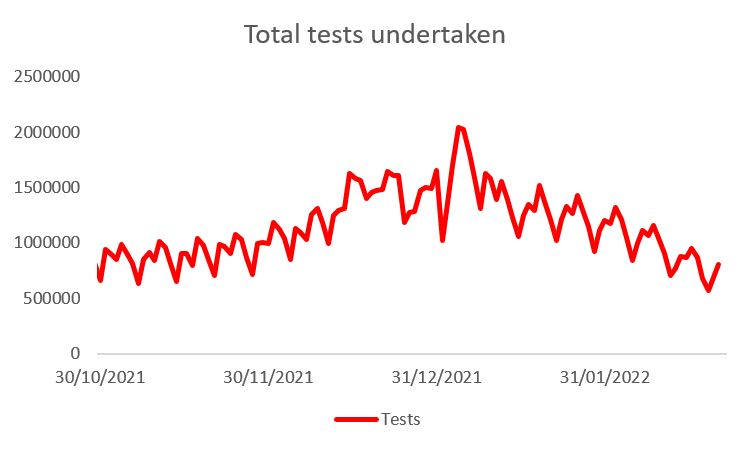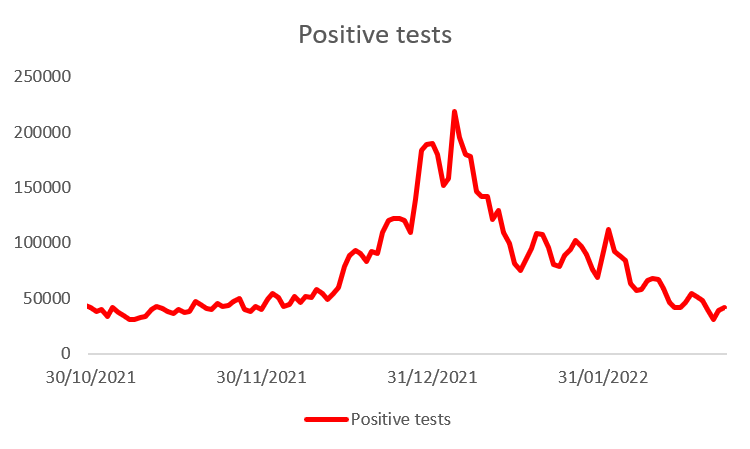24 February 2022
Lies, Damned Lies and Coronavirus
Down with cases
by David Chilvers

In his House of Commons statement and press conference on Monday, Boris Johnson removed all domestic legal restrictions on individuals relating to COVID-19. As from today (Thursday 24th) it is no longer necessary to self-isolate following a positive coronavirus test but is being left to individuals to do the right thing to protect others. The removal of any need to self-isolate will lessen the likelihood that individuals will undertake tests, as what’s the point of confirming you have COVID-19 if you don’t need to do anything as a result of that confirmation. The likelihood that asymptomatic infection will go undetected will surely rise.
As from 1st April, it will be necessary to pay for all types of COVID-19 tests except for those individuals who are clinically vulnerable. From the press conference it appeared that the NHS will be expected to finance testing from its existing budgets. Private individuals and households will be expected to pay for Lateral Flow Tests at a likely cost of £30 for a box of seven tests. Access to Lateral Flow tests is already being curtailed, with home delivery only available every three days and a cap put each day on the total number of tests that can be requested.
All these actions will result in a drop in testing which is already being seen.

Since the start of 2022, the number of tests undertaken has steadily declined, from a maximum of close to 2 million at the start of the year to around 700,00 currently.
Given the fall in the number of tests undertaken, the number of positive tests has also declined, from a peak of 200k at the start of the year to under 50,000 currently.

This raises the question of the chicken and the egg; is the number of positive tests falling because less tests are being undertaken or are less tests being undertaken because less people think they may have COVID-19. The answer is probably a mix of the two but arithmetically reducing the number of tests will lead to a reduction in the number of “cases” (positive test results). As the level of testing falls further given the reasons outlined above, the number of “cases” detected will fall. Will the Government then declare their policy to be vindicated?
Of course, testing does need to stop at some point. We don’t formally test in home for other infectious diseases such as flu, norovirus and a swathe of childhood illnesses including chickenpox, measles etc. So why should COVID-19 be any different? And of course, in the longer term there can be no real argument with that point of view. But in the short term, why is testing being eliminated now rather than in a few months’ time. The cynic would argue that this change is largely to bolster the Prime Ministers popularity at a time when he is under immense pressure on Partygate and the cost of living crisis.
The new strategy is to focus on surveillance and the ability to ramp up testing should the situation demand, either through the emergence of a new variant and/or changing direction on other metrics including hospitalisations, ICU cases and mortality. Surveillance will be driven by the ONS weekly Infection Survey which is to continue but there have been no public announcements on whether the existing sample size is to be retained. The large current sample provides a lot of granularity by geography and demography enabling public health teams to identify whether there is an issue with particular subgroups. The current high level of genome sequencing allows the rapid identification of new variants, but depends upon a flow of data from PCR tests. So, will the pressure of budgets allow these surveillance tools to operate to their current level of detail?
Being able to ramp up testing again should circumstances demand this is apparently secure, as we have a large stockpile of Lateral Flow Tests which could quickly be made available. But what about capacity to undertake and process PCR tests? At present, there is wide network of testing centres and a number of laboratories whose capacity has been gradually increased over the past two years. If these centres and facilities are mothballed, how quickly can they be brought back into action?
In any event, the availability and quality of data on “cases” is going to deteriorate over the next couple of months and as we commented last week suppressing data is an essential first step towards assuming the problems do not exist anymore and removing evidence- based reporting. Stopping the publication of data means that no-one outside Government knows what is going on, whether this relates to COVID or illegal immigration. As a result, there are less media stories and the Government can focus on other activities. That seems to be what Boris wants to do so that his personal popularity can recover and this does seem to be the over-riding priority. Sir Chris Whitty and Sir Patrick Vallance looked quite uncomfortable in the press conference on Monday and there is limited evidence that the new strategy is “driven by the data”; drivel in the data is more appropriate at the moment.
This article is one of a series, the previous article on data issues is here.

